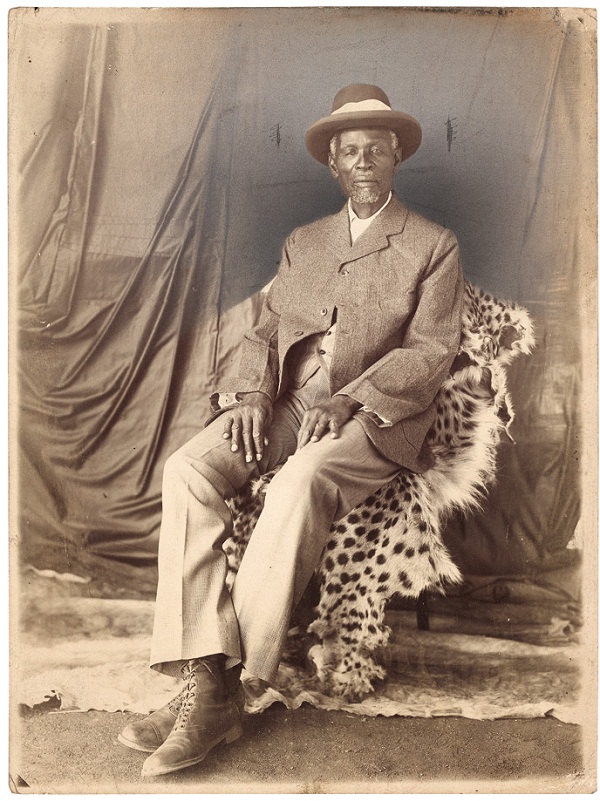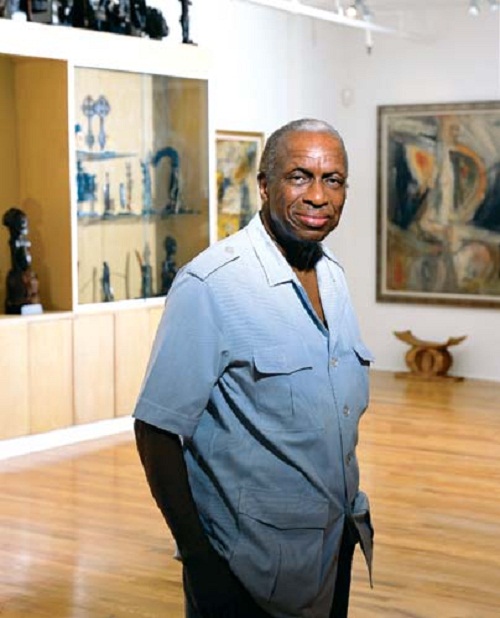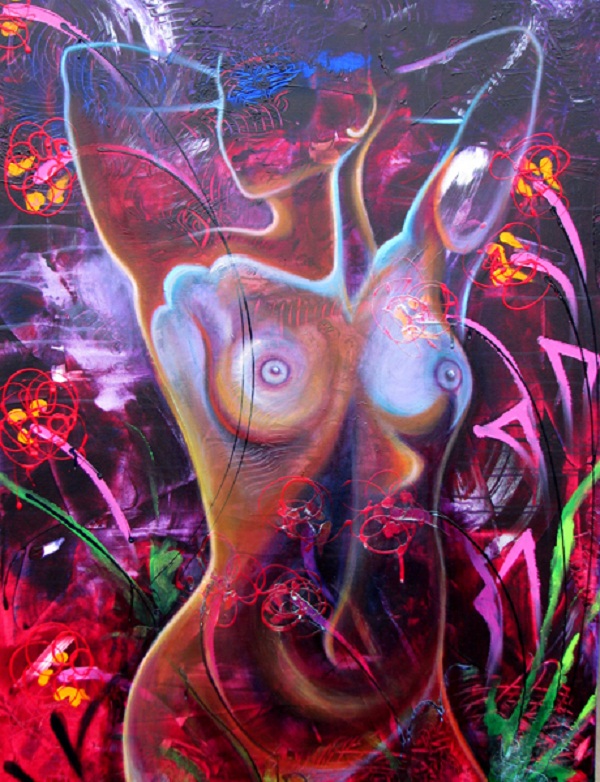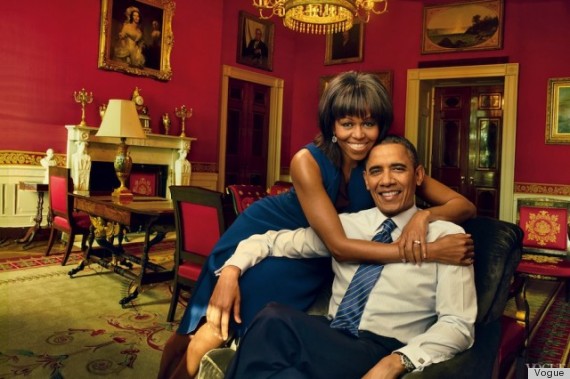NEW YORK: Poetics and Politics

TRANSITION: Merton D. Simpson (1928 – 2013)

Nicki Minaj Shows Lots Of Cleavage In Cut-Out Swimsuit (Video)
“Shy” is certainly not a term used to describe Nicki Minaj. So it’s no surprise the rap goddess isn’t afraid to don a skimpy swimsuit now and again.
Minaj on Tuesday bared her cleavage in a neon, cut-out swimsuit while in a hot tub on the set of her upcoming music video, “High School (feat. Lil Wayne),” according to Us Weekly. The 30-year-old rapper shared the super sexy photos on Twitter with the hashtag #caseyoumissedit.
SCROLL FOR PHOTO
But Minaj is hard to miss.
With her curves on full display, Minaj’s Twitter photos caught the attention of fans. “On the set of High School ft. Lil Wayne,” she tweeted. “Outchea gettin black AF. lmao. I asked the crew to hop in the jacuzzi w/me… they declined…”
Director Grizz Lee, who helmed production of the rapper’s “Come On A Cone” video, also tweeted the photos from set.
Although she bared it all (or most of it) in the bandage-style swimsuit, the “Pink Friday” star, who just partnered with Kmart and ShopYourWay, claims she is trying to tone it down these days, telling Us Weekly, “I’m into my new phase where I’m trying to chill down, chill out.”
Minaj appears on the April cover of ELLE magazine showing her cleavage in a leather jacket, but wearing very little makeup. It is a refreshing change for the Queens, N.Y., native who is known for her platinum-blonde wigs, bubblegum-pink lipstick and inch-long eyelashes.
“When I saw myself with barely any makeup at, it was such a… like, I’m so, so attached to my pink lipstick, it’s hard,” she tells ELLE. “I feel that it’s become a part of me. To go in front of the camera, without pink lips or big ol’ crazy lashes- you know, nothing – I felt naked. It was scary! So this photo shoot was a real accomplishment in my eyes.”
Hillary-Michelle In 2016? Clinton, Obama Pairing Dubbed A ‘Dream Team’
The Huffington Post | By Dominique Mosbergen
The 2016 election may still be several years away, but some democrats are already getting excited about a political match that they say is made in heaven: Hillary Clinton and First Lady Michelle Obama on the presidential ticket.
“All due respect for President Obama and Vice President Biden, but that would truly be a dream team for America,” Karen Finney, a former spokesperson for the Democratic Party and Clinton, told the Washington Examiner. “Both women are proven effective leaders who’ve raise children, so dealing with Congress would be a snap.”
Democratic strategist Chris Lehane, who worked closely with the Clinton White House, told the paper that all this talk of a Clinton-Obama partnership “reflects the growing awareness that it is time for the glass ceiling of the last old boys club to be firmly shattered.”
Visit the Washington Examiner for more details about the buzz.
Though Clinton has remained enigmatic about her future in politics, Fox affiliate KTVI reports that the former secretary of state has “remained the popular choice among Democratic hopefuls” for the 2016 presidential ticket.
As for FLOTUS, Obama has previously dismissed suggestions that she will run for political office when her husband leaves the White House. Still, there has been no shortage of speculation that the powerhouse first lady will get more involved in politics in the near future.
“Nothing she’s done indicates she wants more power on the national or international front,” Debbie Walsh, director of the Center for American Women and Politics at Rutgers University, told Newsweek of Obama in December. “Yet everyone else says she has to have it.”
“I think she will run for something because I think she is just too capable, and now a public figure and interested in public policy,” Lanny Davis, founder of Purple Nation Solutions, told HuffPost Live in February. “I think the temptation will be great, the public service pressure will be great, and I think her husband will say go for it.”
Rep. James Clyburn (D-S.C.) told Newsweek last year that he would “love” to see Obama dabble more into politics.
“It would be a breath of fresh air in D.C.,” he said. “She’s honest and straightforward, which is not what you see in Washington much. She is exactly what we need around here.”
What do you think of a Clinton-Obama presidential ticket? Tell us in the comments.
Michelle Obama’s Vogue Cover For April Exceeded Our Expectations
The Huffington Post | By Rebecca Adams
Michelle Obama’s Vogue cover is finally here!
After weeks of speculating (and speculating), the first lady’s second cover for the fashion glossy has arrived — and it’s absolutely stunning. As expected, photographer Annie Leibovitz shot Michelle, who wore a blue and purple Reed Krakoff sheath plucked straight from her very own closet. The green background, the cool color palette and the choice to wear Reed Krakoff definitely reminded us of FLOTUS’ official portrait.
Vogue’s fashion editor Tonne Goodman led the team styling Mrs. O and the president, who appears in a photo inside the mag with the first lady. Also in the editorial? A third shot of Michelle wearing an elegant Michael Kors ball skirt and sweater. To accompany the shoot, the first couple was interviewed by Jonathan Van Meter, discussing parenting, marriage and their duties while presiding in the White House. Of course, since this is Vogue, they also talked fashion.
“If you’re comfortable in your clothes it’s easy to connect with people and make them feel comfortable as well,” Michelle said.
FLOTUS certainly looks comfortable on her new Vogue cover, which includes her three second term signatures: bangs, Reed Krakoff, and, of course, her amazingly toned arms. Last time she covered the style bible, Michelle’s designer of choice was Jason Wu — with another Reed Krakoff pick this time around, it’s clear we’ve entered a new era of FLOTUS fashion.
Look out for the April issue of Vogue on newsstands in the next couple of weeks.
St. Patrick’s Day – History (Video)
St. Patrick’s Day is celebrated on March 17, the saint’s religious feast day and the anniversary of his death in the fifth century. The Irish have observed this day as a religious holiday for over 1,000 years. On St. Patrick’s Day, which falls during the Christian season of Lent, Irish families would traditionally attend church in the morning and celebrate in the afternoon. Lenten prohibitions against the consumption of meat were waived and people would dance, drink and feast–on the traditional meal of Irish bacon and cabbage.
St. Patrick and the First St. Patrick’s Day Parade
Saint Patrick, who lived during the fifth century, is the patron saint and national apostle of Ireland. Born in Roman Britain, he was kidnapped and brought to Ireland as a slave at the age of 16. He later escaped, but returned to Ireland and was credited with bringing Christianity to its people. In the centuries following Patrick’s death (believed to have been on March 17, 461), the mythology surrounding his life became ever more ingrained in the Irish culture: Perhaps the most well known legend is that he explained the Holy Trinity (Father, Son and Holy Spirit) using the three leaves of a native Irish clover, the shamrock.
Since around the ninth or 10th century, people in Ireland have been observing the Roman Catholic feast day of St. Patrick on March 17. Interestingly, however, the first parade held to honor St. Patrick’s Day took place not in Ireland but in the United States. On March 17, 1762, Irish soldiers serving in the English military marched through New York City. Along with their music, the parade helped the soldiers reconnect with their Irish roots, as well as with fellow Irishmen serving in the English army.
Growth of St. Patrick’s Day Celebrations
Over the next 35 years, Irish patriotism among American immigrants flourished, prompting the rise of so-called “Irish Aid” societies like the Friendly Sons of Saint Patrick and the Hibernian Society. Each group would hold annual parades featuring bagpipes (which actually first became popular in the Scottish and British armies) and drums.
In 1848, several New York Irish Aid societies decided to unite their parades to form one official New York City St. Patrick’s Day Parade. Today, that parade is the world ‘s oldest civilian parade and the largest in the United States, with over 150,000 participants. Each year, nearly 3 million people line the 1.5-mile parade route to watch the procession, which takes more than five hours. Boston, Chicago, Philadelphia and Savannah also celebrate the day with parades involving between 10,000 and 20,000 participants each.
St. Patrick’s Day, No Irish Need Apply and the “Green Machine”
Up until the mid-19th century, most Irish immigrants in America were members of the Protestant middle class. When the Great Potato Famine hit Ireland in 1845, close to 1 million poor and uneducated Irish Catholics began pouring into America to escape starvation. Despised for their alien religious beliefs and unfamiliar accents by the American Protestant majority, the immigrants had trouble finding even menial jobs. When Irish Americans in the country’s cities took to the streets on St. Patrick’s Day to celebrate their heritage, newspapers portrayed them in cartoons as drunk, violent monkeys.
The American Irish soon began to realize, however, that their large and growing numbers endowed them with a political power that had yet to be exploited. They started to organize, and their voting block, known as the “green machine,” became an important swing vote for political hopefuls. Suddenly, annual St. Patrick’s Day parades became a show of strength for Irish Americans, as well as a must-attend event for a slew of political candidates. In 1948, President Harry S. Truman attended New York City ‘s St. Patrick’s Day parade, a proud moment for the many Irish Americans whose ancestors had to fight stereotypes and racial prejudice to find acceptance in the New World.
The Chicago River on St. Patrick’s Day
As Irish immigrants spread out over the United States, other cities developed their own traditions. One of these is Chicago’s annual dyeing of the Chicago River green. The practice started in 1962, when city pollution-control workers used dyes to trace illegal sewage discharges and realized that the green dye might provide a unique way to celebrate the holiday. That year, they released 100 pounds of green vegetable dye into the river–enough to keep it green for a week! Today, in order to minimize environmental damage, only 40 pounds of dye are used, and the river turns green for only several hours.
Although Chicago historians claim their city’s idea for a river of green was original, some natives of Savannah, Georgia (whose St. Patrick’s Day parade, the oldest in the nation, dates back to 1813) believe the idea originated in their town. They point out that, in 1961, a hotel restaurant manager named Tom Woolley convinced city officials to dye Savannah’s river green. The experiment didn’t exactly work as planned, and the water only took on a slight greenish hue. Savannah never attempted to dye its river again, but Woolley maintains (though others refute the claim) that he personally suggested the idea to Chicago’s Mayor Richard J. Daley.
St. Patrick’s Day Around the World
Today, people of all backgrounds celebrate St. Patrick’s Day, especially throughout the United States, Canada and Australia. Although North America is home to the largest productions, St. Patrick’s Day is celebrated in many other locations far from Ireland, including Japan, Singapore and Russia.
In modern-day Ireland, St. Patrick’s Day was traditionally been a religious occasion. In fact, up until the 1970s, Irish laws mandated that pubs be closed on March 17. Beginning in 1995, however, the Irish government began a national campaign to use interest in St. Patrick’s Day to drive tourism and showcase Ireland and Irish culture to the rest of the world. Today, approximately 1 million people annually take part in Ireland ‘s St. Patrick’s Festival in Dublin, a multi-day celebration featuring parades, concerts, outdoor theater productions and fireworks shows.
The History of the Dukes of Destiny (as told by John Colgan-Davis)
It was a rambling three story house on the edge of the woods in Philadelphia’s Fairmount Park. The year was 1984 and four young musicians lived in that house, spending hour upon hour jamming on old blues songs. They decided to take the act out as The Dukes of Destiny, a name they got from a matchbook cover urging the reader to “Be the Captain of Your Own Destiny.” At first they played house parties in Germantown, generating word of mouth interest. A gig at the now-defunct Taker’s Cafe in Germantown launched their public career, and 20 years later they are still playing some of the hottest, most danceable blues and R’n’B in the Philadelphia area. The Dukes of Destiny reign as one of Philadelphia’s longest lived blues act.
In all these years, there have only been a few changes in the act. Turk McFadden, the Dukes original drummer (who previously played in the original “Slant 6” band with founding member Steve Brown)left after the first year to spend more time with his new family. He can still be found playing gigs throughout the Tri-State area. Sax player Steve Bernstein left to tour with pianist W.C. Clark (who co-wrote “Cold Shot” with Stevie Ray Vaughn) and later moved to Austin, where he plays R&B in those cool Austin clubs. Guitarist A.C. Steel left to start his own band (A.C. Steel and the Galvinizers) and plays gigs from time to time in and around the Philly area.
Although original singer Steve Brown died in March of 2000, the core of the band has remained together for all of those 25 years, resulting in a band with a unique tightness and an original approach to the music:
Harmonica player and singer John Colgan-Davis has played in the Philadelphia area for more than 30 years, playing and touring with such notables as Bonnie Raitt, Tennessee bluesman Sparky Rucker, the John Cadillac Band, and the legendary guitarist Mississippi Fred McDowell.
Drummer Bob Holden has played with Robert Hazzard and Columbia Records recording artist Quincy.
Before the Dukes, guitarist Richard Adler played around Philly in a mostly acoustic duo with Steve Brown, beginning way back in 1975.
Carl Crabtree (“CC”) is a longtime Philly sax player, who has played with many area bands.
Bassist Rich Curtis has led his own jazz groups and played with guitarist Jim Dragoni, percussionist Doc Gibbs, and Saxman Bayard Lancaster.
Arlyn Wolters joined the Dukes in early 2003 as our new lead vocalist. Arlyn sang blues and R&B in NYC clubs before moving to Philly and joining the Dukes. Together, the Dukes represent more than 100 years of professional experience and exploration of American roots music.
Keyboardist Carl Snyder is the Dukes’ most recent addition. Carl was based in Chicago for many years and has played and toured with some of the best Chicago Blues bands. He also hosts a local radio show.
Over the last 25 years the Dukes have gained a large and loyal following among Philadelphia listeners who know and love the blues. They’ve appeared at four River Blues Festivals at Penn’s Landing, five concerts sponsored by the Philadelphia Blues Machine, the YO Philadelphia Festival sponsored by the Daily News, and the Pocono Blues Festival. They have also been an opening act for such greats as Albert King, Charlie Musselwhite, Commander Cody, Gatemouth Brown, Koko Taylor, John Lee Hooker, and John Mayall. They have also served as the backup band for legendary Chicago guitarist/singer Otis Rush. Most recently, Duke members Bob Holden, John Colgan-Davis, and Rich Curtis served as the backup band for singer Terry Evans at performances at TRAMMPS in New York City and the Penn State Festival of the Arts. They also received an award from the Philadelphia Folk Song Society in 1993. With a mix of their own arrangements of obscure blues standards and powerful original songs, the Dukes continue to grow and develop. Their solid musicianship and love of the music inspires fans and critics alike.
The Dukes have released three CD’s that have received airplay on WHYY, WRTI, and WXPN. The first one,”The Dukes of Destiny“, was released in 1991. The second, “House of Forbidden Love” was released to solid reviews in 1997. It features guest appearances by bassist Steve Beskrone, a veteran of Ray Charles’ band, and Motown percussionist Jack Ashford. The third, “3“, was released in October, 2004 and is the first to showcase Arlyn Wolters on vocals. It also features Carl “CC” Crabtree on saxophones and Walter Runge Jr. on keyboards.
“We’re a band”, harmonica player John Colgan-Davis said. “We’re not So-and-So and his backup group. We play off of each other’s energy and creativity. We have fun, and that comes across to the audience. If you come to a Dukes gig, be prepared for a lot of dancing and some big smiles. We love playing together and it shows.”
It’s been 25 exciting fun-filled years for the Dukes of Destiny. The energy and excitement they generate says that there are still many more years yet to come.
Iran & ‘Argo’: Authorities Reportedly Planning On Suing Hollywood
By NASSER KARIMI
TEHRAN, Iran — Iran is planning to sue Hollywood over the Oscar-winning “Argo” because of the movie’s allegedly “unrealistic portrayal” of the country, Iranian media reported Tuesday.
Several news outlets, including the pro-reform Shargh daily, said French lawyer Isabelle Coutant-Peyre is in Iran for talks with officials over how and where to file the lawsuit. She is also the lawyer for notorious Venezuelan-born terrorist Ilich Ramirez Sanchez, known as Carlos the Jackal.
Following the 1979 attack on the U.S. Embassy in Tehran, 52 Americans were held hostage for 444 days, but six embassy staffers were sheltered by the Canadian ambassador. Their escape, using a fake movie as a cover story, is recounted in “Argo.”
After its Oscar win in February, Iranian officials dismissed “Argo” as pro-CIA, anti-Iran propaganda.
The lawyer told the semi-official Mehr news agency that she will start a campaign to show that Argo is a lie, while pressing to stop distribution of the movie.
“We will be able to block distributors of the movie, force them to apologize and challenge them to confess that the movie is nothing but a sheer lie,” the lawyer said.
Though the movie isn’t showing in any Iranian theaters, many Iranians have seen it on bootleg DVDs and it set off a spirited debate that exposed a generational divide. Iranians who took part in the 1979 Islamic Revolution picked apart the portrayals of Tehran at the time but those too young to recall the events were eager for a different view on what had happened.
The decision on the lawsuit came after a group of Iranian cultural officials and movie critics screened the film in a closed audience in a Tehran theater late Monday.
The gathering, titled “The Hoax of Hollywood,” discussed various legal aspects of filing a lawsuit, media reports said, without providing details. It remains unclear what specific charges Iran could raise and what court Tehran could turn to if the action goes ahead.
Those at the meeting dismissed “Argo” as a “violation of international cultural norms.” A statement issued after the gathering said that “awarding an anti-Iran movie is a propaganda attack against our nation and entire humanity.”
The statement did not clarify how the movie was allegedly unrealistic, but officials have accused “Argo” of depicting Iranians as “too violent.”
They have also said the movie’s director did not refer to other documentaries on the embassy storming or discuss reasons for the crisis, which included simmering resentment against the United States for a CIA-aided counter-coup in 1953 that toppled democratically elected Prime Minister Mohammad Mossadegh and restored the pro-Western monarchy in Iran.
This was not the first time Iran has claimed that Hollywood has pushed a distorted picture of the country.
In 2009, Iran demanded an apology from a team of visiting Hollywood actors and movie industry officials, including Annette Bening, saying films such as “300” and “The Wrestler” were “insulting” to Iranians.
In 2007, the hit American movie “300” angered Iranians who said the Greeks-versus-Persians action flick insults their ancient culture and provokes animosity against Iran.
The 1991 film “Not Without My Daughter” – the true story of an American women fleeing Iran with her young daughter, angered Iranians who accused it of casting Iranians as dirty, boorish and cruel, obsessed with Islam and misogynist attitudes toward women.
Iran’s state-run film industry boycotted this year’s Oscars in the wake of an Internet video clip made in the U.S. denigrating the Prophet Muhammad that set off protests across the Muslim world.
The affair wasn’t related to “Argo.”
Justin Timberlake On Kanye West’s ‘Suit And Tie’ Diss On ‘Late Night’
The Huffington Post | By Madeline Boardman
On Saturday night, Justin Timberlake returned to “Saturday Night Live” for his fifth hosting gig, bringing an impressive cast of alums to guest star, including Steve Martin, Tom Hanks, and Candice Bergen. But the moment that all Timberlake fans were buzzing about was one line in JT’s performance of his hit single, “Suit & Tie,” with Jay-Z.
Rather than performing the song’s original line of “S–t so sick got a hit and picked up a habit,” Timberlake sang “My hit’s so sick got rappers acting dramatic,” a move many interpreted as a response to Kanye West. Last month, West slammed “Suit & Tie” during a concert in London, telling the audience, “I got love for Hov, but I ain’t f–kin’ with that ‘Suit & Tie.'”
Timberlake adressed the lyric swap on Monday’s “Late Night” with Jimmy Fallon. In the video shown above, Fallon asks Timberlake, “For ‘Saturday Night Live,’ it felt like to me you changed one of the lyrics in ‘Suit & Tie.'” “Did it seem that way?” Timberlake asked, feigning disbelief. “I don’t remember that… Did I change a line? It is live. You know, really, everyone, keep calm.” To which Fallon responded, “Keep calm, and Kanye on.” Fallon’s mention of Kanye prompted Timberlake to address the rapper, telling the audience, “Let me just, for the record… I absolutely love Kanye. So there’s that. We love Kanye, right?”
Timberlake also performed his new song “Pusher Love Girl” on the show (shown below). The track is a single off of JT’s upcoming album, “The 20/20 Experience.” He surprised fans on Monday by streaming the album in its entirety on iTunes, one week ahead of its March 19 release date.
Halle Berry’s Cleavage Proves Distracting For Jay Leno
It’s no secret that Halle Berry oozes sex appeal. The Bond girl can leave men in a dribbling state of awe simply by flashing her smile — so you can imagine the effect she had on Jay Leno after showing up in one of the lowest necklines we’ve ever seen.
For her appearance on “The Tonight Show With Jay Leno” last night, the 46-year-old donned a skimpy Reem Acra LBD with silver trim. The sheer mesh bust line was on the low side, but it also featured a slit down the middle all the way to her belly button — yowza! Needless to say, Jay had a tough time focusing on the topic at hand.
Halle dished to the comedian about what went into choosing her Versace gown for the 2013 Academy Awards. Like many actresses (ahem, Anne Hathaway), she had a backup option should the chosen dress have any last-minute issues:
“You know, I almost didn’t wear that [Versace] dress … I had a conversation with Donatella Versace. I told her that I wanted to go to the Oscars as a Bond girl. Like, if a Bond girl would go in 2013. So she came up with what her idea of it was, but you know she’s out in the country so she put it in a suitcase and shipped it here. I got it a day before the Oscars … The day before, I had some other dress I was going to wear, which was beautiful, but I pulled this out and it was like [makes lightning noise]. It fit perfectly and I just thought ‘wow.'”
To put it into context for the car-loving host, Halle added: “I felt like I was — you’ll appreciate this — wearing a Ferrari,” to which Jay responded with a smirk, “Can you drive a stick shift? I’m just curious.” Typical…
Like we said though, Halle’s choice of dress for the interview was… distracting. Can you blame Jay for saying what’s on his mind?
University of Delaware Museums
University Museums Mission
The University Museums seeks to enhance the educational and scholarly mission of the University of Delaware through the exhibition, online presentation, study, preservation and growth of its unique collections in 20th and 21st century American art (with particular strengths in the Brandywine School, African American art, and photography), minerals and pre-Columbian ceramics. The University Museums enriches cultural life beyond the campus through presentation of the work of recognized artists, and through outreach programs to selected audiences, including K-12 students, educators and historically black colleges and universities.
Mechanical Hall
Following an award winning renovation, Mechanical Hall reopened in 2004 as the home of the Paul R. Jones Collection of African American Art. This gift to the University by the Atlanta collector Paul R. Jones has served as a point of departure for a growing collection of African American art, as well as related faculty and student initiatives.
The African American art collection at UD today includes the founding Paul R. Jones gift, an impressive survey of prints from the Brandywine Workshop in Philadelphia, and important photographs by P.H. Polk. The gallery in Mechanical Hall offers changing exhibitions of African American Art and related topics. In addition to gallery space, the building houses a print room for the use of those studying objects in the collection.
Built in 1898, Mechanical Hall is on the National Register of Historic Places. Its purpose changed throughout the twentieth century, serving as an engineering building, an athletic training center, a residence for GI’s returning to school after World War II, and a ROTC building.
The Mineralogical Museum
The Mineralogical Museum in Penny Hall originated with the gift of the Irenée du Pont, Sr. collection in 1964. A significant part of this collection was purchased in 1919 by Mr. du Pont from George Kunz, Vice-President of Tiffany & Co, and had been on display in the Tiffany showroom in New York City.
A grant from the Crystal Trust enabled the University to move the collection from the University Library to a new facility in Penny Hall in the early 1970s. Mrs. David S. Craven, a niece of Irenée du Pont, for many years provided annual funds for acquisitions and for care of the collection, which has grown in size and in quality over the years with the support of David A. Byers, Frederick A. Keidel, Alvin B. Stiles and other generous donors.
The Mineralogical Museum supports the programs of the University, provides educational resources for regional schools and attracts mineral enthusiasts. The Museum was renovated in 2009 and displays approximately 450 specimens with a focus on crystallized minerals, including gem minerals, classics from early European and American localities and specimens from significant recent discoveries.
The Old College Gallery
The Old College Gallery is housed in Old College, a National Historic Register building constructed in 1834, on the north campus of the University of Delaware in Newark. Following renovation, Old College Gallery reopened in fall 2010 at the home for the University of Delaware art collection.
Highlights on view include significant works by Brandywine School artists Howard Pyle, Stanley Arthurs, Frank Schoonover, and N.C. Wyeth; Pre-Columbian and Southwest Native American ceramics and American sculpture and painting of the 20th century. A select collection of Russian icons from the late eighteenth and nineteenth centuries is also on view.
In addition to the permanent exhibition, the Old College Gallery features changing exhibitions, focusing on works from the Permanent Collection as well as loan exhibitions. Recent and upcoming exhibitions include: Andy Warhol:Behind the Camera; Natural Histories: Recent work by Virginia Bradley; Recent Gifts and Acquisitions and Gertrude Kasebier.
Edmund Pettus Bridge, ‘Bloody Sunday’ Site, Declared A Historic Landmark (Video)

Forty eight years ago, the Edmund Pettus Bridge was the site of a horrific attack on some 600 civil rights demonstrators, traveling from Selma to Montgomery. When the then Alabama governor George Wallace ordered state and local police to stop the march on grounds of public safety, the group was confronted by authorities armed with billy clubs and tear gas in what infamously became known as “Bloody Sunday.”
Today, the Secretary of the Interior Ken Salazar and the Director of the National Park Service Jonathan B. Jarvis declared the bridge a historic landmark, honoring it’s significance as a site of a major turning point in the Civil Rights Movement.
The bridge is one of 13 new sites to receive national recognition, including the home of “Uncle Tom’s Cabin” author Harriet Beecher Stowe, and is also the location of the annual reenactment of the march.
“From the Civil War to civil rights, to the struggles and accomplishments of women, African Americans and Latinos, these sites highlight the mosaic of our nation’s historic past,” said Director Jarvis. “We are proud to administer the National Historic Landmarks Program to educate and inspire Americans through their country’s rich and complex history.”
The “Bloody Sunday” attack contributed heavily to the passage of the 1965 Voting Rights Act, a law that is widely considered to be the country’s most effective piece of civil rights legislation. Currently, the law is facing potential changes to Section 5, which requires states with a history of racial discrimination to receive approval from the Justice Department before changing election procedures.
“For many of us who are familiar with the statute, we know that Section 5 is the main reason why the Voting Rights Act is the most effective civil rights statute we’ve ever passed in this country,” Julie Fernandes, a senior policy analyst at the Open Society Foundations, told The Huffington Post.
Despite the debate surrounding the Voting Rights Act, there is no doubt that the Edmund Pettus Bridge holds special significance in the nation’s history, a sentiment Salazar shared in his dedication.
“Today’s designations include significant sites that help tell the story of America and the contributions that all people from all walks of life have made as we strive for a more perfect union.”
Art Investment by October Gallery Staff
With the high value placed on powerful, socially-relevant art of today and the timeless works of history’s greats, art will always be an intriguing and sought after form of investment. Art is still a powerful medium of influence and serves an important role in the evolution of visual and popular culture. While the Italian Renaissance is fondly recalled as an era of creative, artistic innovation, history truly revealed that most art projects were funded by religious institutions. For the Catholic Church, visual art was an important investment because it was critical for spreading its mission to the masses and encourage church membership. The major funding and investment of Italian Renaissance art exposed a reality about the art world that was separate from the artistic genius of masters, technique and theory.
The art world is extremely particular, fast-paced and has always crossed paths with the business world and institutions of influence. While the term “starving artist” was undoubtedly the reality of many working yet unsuccessful artists like Van Gogh, there have always been those major success stories of working artists living the dream. Behind that dream, however, is the financial investment of powerful, influential patrons. While people invest their money to foster the growth of a business or artist, investors also contribute because major financial gains could await down the road. While an artist’s passion compels them to create, surviving off that passion may require creative compromise in their career. Those who invest in working artists, and the pieces they’re presently making, can undoubtedly have an influence about what is made and where it’s shown.
Overall, investment is risky by nature regardless of the product. Whether it’s stocks, companies or fine art, an investor knowingly goes into the decision with the weight of potential success or possible failure. Like any other forms of investment, confidence in the economy determines whether art is a wise investment choice or an unnecessary and potentially harmful one. Throughout the course of art history, leading art movements have attracted investors with money to burn. However, harsh economic conditions, like the Great Depression, scared most potential investors away from art; the lack of art investment drove artists into destitution and prompted government programs to employ them for public works projects.
While art history has revealed the negative impact of bad economies on art investment, it has powerfully shown the influence economic confidence can produce. The extravagant culture and rampant spending behavior of the 1980s made an indelible mark on the art industry. People were investing in art at a rapid pace which created overnight sensations like Keith Harring and Jean-Michael Basquiat. The reckless abandon of the 1980s, and the popularity of pop-contemporary art, opened the flood gates for a wave of new artists and investors. While that manic investment if art has since slowed down, the value of artists’ works, deceased and present, continues to draw investors, rise in value and sell for staggering amounts at renown auction houses.
$228k for one of the greatest African-American artists
by Paul Fraser
An important painting in the history of African-American visual art featured alongside this very unique Sargent Claude Johnson sculpture at Swann Auction Galleries’ African Americana Printed & Manuscript auction, last Tuesday (February 23).
Swing Low, Sweet Chariot is not only artist Malvin Gray Johnson’s (1896-1934) best-known work, it was also one of the first modern paintings to be recorded in the canon of African-American art and culture.
Due to Johnson’s sudden death, aged just 38, his works are very scarce. This was the artist’s first painting to come to auction.
The 1928-29 painting launched Johnson’s career and placed him alongside Aaron Douglas and Henry Ossawa Tanner in the pantheon of greatest African-American artists of their time.
It also made him a star at Swann, surpassing its lower $200,000 estimate with a final hammer price of $228,000.
Elsewhere, Sargent Claude Johnson’s sculpture Untitled (Standing Woman), an innovative and important depiction of an African-American woman, sold for $44,000.
Meanwhile, a large and important collection archived by a Howard University academic was the leading lot at Swann Galleries’ sale of African Americana on Thursday (February 25).
Assembled by James Amos Porter (1905-1970), one of America’s pioneering art historians as well as an artist and author in his own right, the materials were the source for his book, Modern Negro Art, published in 1943.
The product of five years’ research, the collection was also the basis of Porter’s courses, lectures and literally hundreds of articles in various publications over the course of his long career.
The archive includes correspondence from virtually every major African-American artist from the 1920s forward: Romare Bearden, Lois Mailou Jones, Meta Warwick Fuller and scores of others, with many of Porter’s replies or queries retained.
These sold with hundreds of contemporary photographs of work by virtually all of the major black artists of the 20th century.
Porter’s collection also included numerous exhibit catalogues – many of which are virtually unobtainable today.
This unique, singular and irreplaceable document of African-American art history surpassed its $30,000-40,000 pre-sale estimate, eventually realising $42,000.
About the Author
Paul Fraser has been involved in high-end collectibles for over 35 years, selling more than $300m of rare items, including John Lennon’s childhood stamp album to the Smithsonian. Paul Fraser Collectibles offers a free high-end collectibles newsletter service with expert opinion and advice











